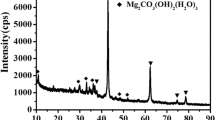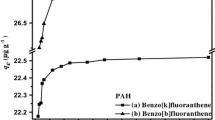Abstract
Five amino-functionalized mesoporous materials were directly synthesized by an evaporation-induced self-assembly method. A series of environmentally friendly surfactants as templates were used, including dimethyl dioctadecyl ammonium bromide, polyethylene glycol (PEG), alkyl polyglucoside, and cetyl dimethyl betaine, in order to reduce damage to the environment in templates elution during the synthesis process. These samples were found to have two-dimensional hexagonal mesoporous structures and worm-like pores characterized by small-angle X-ray diffraction and transmission electron microscopy. Larger mesoporous pore sizes (9.8–17.9 nm) and pore volumes (0.443–0.652 cm3 g−1) were determined by N2 adsorption–desorption. Amino-functional groups were modified onto mesoporous materials, which were proved by fourier transform infrared spectroscopy and elemental analysis. PEG-S (synthesized by PEG) had the biggest pore size (17.9 nm), the highest nitrogen content (4.237 %) and relatively large pore volume (0.507 cm3 g−1) among five samples. Adsorption of Pb(II) onto five mesoporous samples differed greatly at initial concentration ranging from 0.3 to 2.6 mmol L−1. PEG-S had largest adsorption capacity, with maximum adsorption capacity being 1.166 mmol g−1 (241.36 mg g−1) in initial 1.6 mmol L−1 Pb(II) concentration. PEG is nontoxic and readily biodegradable, and PEG-S displayed the maximum adsorption capacity in the study. Therefore, PEG-S samples were selected for processing lead ions. Then further study was made to investigate lead ions adsorption isotherm, the effect of pH value on the adsorption, as well as the reuses of adsorbents.










Similar content being viewed by others
References
Machida M, Mochimaru T, Tatsumoto Hideki (2006) Lead(II) adsorption onto graphene layer of carbonaceous materials in aqueous solution. Carbon 5(44):2681–2688
Hui Li Yan, Di Zechao, Ding Jun et al (2005) Adsorption thermodynamic, kinetic and desorption studies of Pb2+ on carbon nanotubes. Water Res 4(39):605–612
Huang ZH, Zheng X, Lv W et al (2011) Adsorption of lead(II) ions from aqueous solution on low-temperature exfoliated graphene nanosheets. Langmuir 4(27):7558–7562
Kresge CT, Leonowicz ME, Roth WJ (1992) Ordered mesoporous molecular sieves synthesized by a liquid-crystal template mechanism. Nature 359(6397):710–712
Kozhevnikov IV, Kloetstra KR (1996) Study of catalysts comprising heteropoly acid H3PW12O40 supported on MCM-41 molecular sieve and amorphous silica. J Mol Catal A 114(1–3):287–298
Wang Zhuqing Wu, Genhua Wang Min, Chiyang He (2009) An imprinted organic-inorganic hybrid sorbent for selective separation of copper ion from aqueous solution. J Mater Sci 44:2694–2699. doi:10.1007/s10853-009-3353-7
Fu J, Chen ZH, Wang MH et al (2015) Adsorption of methylene blue by a high-efficiency adsorbent (polydopamine microspheres): kinetics, isotherm, thermodynamics and mechanism analysis. Chem Eng J 259:53–61
Shalan AE, Rasly M, Rashad MM (2014) Organic acid precursor synthesis and environmental photocatalysis applications of mesoporous anatase TiO2 doped with different transition metal ions. J Mater Sci 25:594–602. doi:10.1007/s10854-014-1995-y
Kalbasi RJ, Mosaddegh N (2012) Characterization and catalytic performance of poly(4-vinylpyridine) supported on mesoporous carbon: comparison with poly(4-vinylpyridine) supported on mesoporous silica. J Porous Mater 19(5):557–565
Kumar VB, Annamanedi M, Prashad MD, Arunasree KM, Mastai Y, Gedanken A, Paik P (2013) Synthesis of mesoporous SiO2–ZnO nanocapsules: encapsulation of small biomolecules for drugs and “SiO2–ZnO -plex” for gene delivery. J Nanopart Res 132(9):411–418
Jeong E, Park S (2012) Synthesis of porphyrin-bridged periodic mesoporous organosilica and their catalytic applications. Res Chem Intermed 38(6):1237–1248
Kelly JA, Giese M, Shopsowitz KE (2014) The development of chiral nematic mesoporous materials. Acc Chem Res 47(4):1088–1096
Awual MR, Hasan MM, Znad H (2015) Organic–inorganic based nano-conjugate adsorbent for selective palladium (II) detection, separation and recovery. Chem Eng J 259:611–619
Kim H, Park DR, Park S, Jung JC, Lee S, Song IK (2009) Preparation, characterization, and catalytic activity of H5PMo10V2O40 immobilized on nitrogen-containing mesoporous carbon (PMo10V2/N-MC) for selective conversion of methanol to dimethoxymethane. Korean J Chem Eng 26(3):660–665
Hernández-Morales V, Nava R, Acosta-Silva YJ, Macías-Sánchez SA, Pérez-Bueno JJ, Pawelec B (2012) Adsorption of lead (II) on SBA-15 mesoporous molecular sieve functionalized with –NH2 groups. Microporous Mesoporous Mater 160:133–142
Henrist C, Dewalque J, Mathis F, Cloots R (2009) Control of the porosity of anatase thin films prepared by EISA: influence of thickness and heat treatment. Microporous Mesoporous Mater 117(1–2):292–296
Liu H, Yang Y (2014) Effects of different chain lengths and chiral branched amino acids on the synthesis of mesoporous silica. J Nanosci Nanotechnol 14:5518–5528
Houshang F, Fatemeh, Rahmatollah R, Ali G (2014) Surfactant-free hydrothermal synthesis of mesoporous niobia samples and their photoinduced decomposition of terephthalic acid (TPA). J Cluster Sci 25(2):651–666
Tungkananurak K, Kerdsiri S, Jadsadapattarakul, Burns DT (2007) Semi-micro preparation and characterization of mesoporous silica microspheres from rice husk sodium silicate using a non-ionic surfactant as a template: application in normal phase HPLC columns. Microchim Acta 159(3–4):217–222
Guo W, Sun YW, Luo GS, Wang YJ (2005) Interaction of PEG with ionic surfactant SDS to form template for mesoporous material. Colloids Surf A 252(1):71–77
Hao N, Yang Y, Wang H, Webley PA, Zhao D (2010) Synthesis of large-pore phenyl-bridged mesoporous organosilica with thick walls by evaporation-induced self-assembly for efficient benzene adsorption. J Colloid Interface Sci 346(2):429–435
Zhai Shang Ru, Kim I, Ha C (2008) Synthesis and characterization of periodic mesoporous organosilicas from bridged organosilanes in the presence of mixed salts. J Solid State Chem 181(1):67–74
Yi Liu Chang, Xiao L, Lv H (2007) Direct synthesis of ordered mesoporous carbons from F108-RF composite obtained in basic media of nonaqueous solution. Chem Commun 14:4872–4874
Inagaki Shinji, Guan Shiyou, Ohsuna Tetsu et al (2002) An ordered mesoporous organosilica hybrid material with a crystal-like wall structure. Nature 416:304–307
Lin HP, Kao CP, Mou CY (2001) Counterion and alcohol effect in the formation of mesoporous silica. Microporous Mesoporous Mater 48:135–141
Az ID, Mohino F, Pérez-Pariente JN, Sastre E (2001) Synthesis, characterization and catalytic activity of MCM-41-type mesoporous silicas functionalized with sulfonic acid. Appl Catal A 205(1):19–30
Mahoney L, Koodali RT (2014) Versatility of evaporation-induced self-assembly (EISA) method for preparation of mesoporous TiO2 for energy and environmental applications. Materials 7(4):2697–2746
Vaid C, Murugavel S, Kashayap R, Tandon RP (2012) Synthesis and in vitro bioactivity of surfactant templated mesoporous sodium silicate glasses. Microporous Mesoporous Mater 159:17–23
Zhao R, Guo F, Hu Y et al (2006) Self-assembly synthesis of organized mesoporous alumina by precipitation method in aqueous solution. Microporous Mesoporous Mater 93(1):212–216
Hyder MN, Kavian R, Sultana Z (2014) Vacuum-assisted layer-by-layer nanocomposites for self-standing 3D mesoporous electrodes. Chem Mater 26(18):5310–5318
Hatton BD, Landskron K, Whitnall W, Perovic DD, Ozin GA (2005) Spin-coated periodic mesoporous organosilica thin films towards a new generation of low-dielectric-constant materials. Adv Funct Mater 15(5):823–829
Iqbal M, Saeed A, Zafar SI (2009) FTIR spectrophotometry, kinetics and adsorption isotherms modeling, ion exchange, and EDX analysis for understanding the mechanism of Cd2+ and Pb2+ removal by mango peel waste. J Hazard Mater 164(1):161–171
Hernández-Morales V, Nava R, Acosta-Silva YJ (2012) Adsorption of lead (II) on SBA-15 mesoporous molecular sieve functionalized with –NH2 groups. Microporous Mesoporous Mater 160:133–142
Yokoi Toshiyuki, Yoshitake Hideaki, Yamada Takashi (2006) Amino-functionalized mesoporous silica synthesized by an anionic surfactant templating route. J Mater Chem 16:1125–1135
Yang Hong Xu, Ran Xue Xiaoming (2008) Hybrid surfactant-templated mesoporous silica formed in ethanol and its application for heavy metal removal. J Hazard Mater 152(2):690–698
Jin Huang, Ye Meng, Yuqi Qu (2012) Pb(II) removal from aqueous media by EDTA-modified mesoporous silica SBA-15. J Colloid Interface Sci 385:137–146
Yoshitake H, Yokoi T, Tatsumi T (2002) Anion binding in self-assembled monolayers in mesoporous. Chem Mater 14:4603–4612
Liu K, Zhang M, Shi K, Fu H (2005) Large-pore mesoporous nanocrystalline titania thin films synthesized through evaporation-induced self-assembly. Mater Lett 59(26):3308–3310
Shahbazi Afsaneh, Younesi Habibollah, Badiei Alireza (2011) Functionalized SBA-15 mesoporous silica by melamine-based dendrimer amines for adsorptive characteristics of Pb(II), Cu(II) and Cd(II) heavy metal ions in batch and fixed bed column. Chem Eng J 168(2):505–518
Awual MR, Hasan MM (2014) Novel conjugate adsorbent for visual detection and removal of toxic lead (II) ions from water. Microporous Mesoporous Mater 196:261–269
Wu XW, Ma HW, Yang J (2012) Adsorption of Pb(II) from aqueous solution by a poly-elemental mesoporous adsorbent. Appl Surf Sci 258:5516–5521
Heidari A, Younesi H, Mehraban Z (2009) Removal of Ni(II), Cd(II), and Pb(II) from a ternary aqueous solution by amino functionalized mesoporous and nano mesoporous silica. Chem Eng J 153:70–79
Awual MR, Hasan MM, Shahat A (2014) Functionalized novel mesoporous adsorbent for selective lead (II) ions monitoring and removal from wastewater. Sens Actuators B 203:854–863
Wang S, Wang K, Dai C et al (2015) Adsorption of Pb2+ on amino-functionalized core-shell magnetic mesoporous SBA-15 silica composite. Chem Eng J 262:897–903
El-Toni AM, Habila MA, Ibrahim MA et al (2014) Simple and facile synthesis of amino functionalized hollow core–mesoporous shell silica spheres using anionic surfactant for Pb(II), Cd (II), and Zn (II) adsorption and recovery. Chem Eng J 251:441–451
Wagner CD, Naumkin AV, Kraut-Vass A (2003) NIST-X-ray photoelectron spectroscopy Database 20 Version 3.4. National Institute of Standards and Technology, Gaithersburg, MD. Available online at: http://srdata.nist.gov/xps/
Acknowledgements
This work was financially supported by Natural Science Foundation of Jiangsu Province for Youths (BK2012135), and the National Science and Technology Major Special Projects of China (2011ZX05060-005). Technical support from Jiangsu Key Laboratory of Resources and Environmental Information Engineering was also appreciated. Hong Yang received grants from the Fundamental Research Funds for the Central Universities (2013QNA21).
Author information
Authors and Affiliations
Corresponding author
Rights and permissions
About this article
Cite this article
Tian, H., Feng, Q., Chen, Y. et al. Synthesis of amino-functionalized mesoporous materials with environmentally friendly surfactants by evaporation-induced self-assembly and their application to the adsorption of lead(II) ions. J Mater Sci 50, 2768–2778 (2015). https://doi.org/10.1007/s10853-015-8832-4
Received:
Accepted:
Published:
Issue Date:
DOI: https://doi.org/10.1007/s10853-015-8832-4




